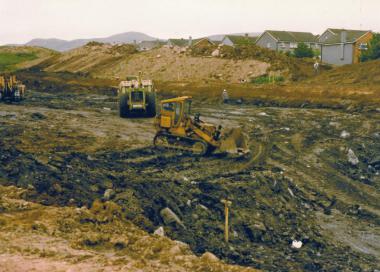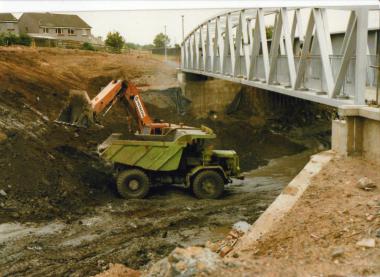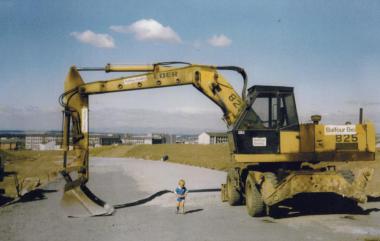It was in fact a long time in coming. In an impassioned speech to Parliament in 1978, reported in Hansard, Lord James Douglas-Hamilton, then MP for Edinburgh West, demanded to know the reason for the “extraordinary and almost scandalous delay”, pointing out that “virtually every transport plan since the Abercrombie Report in 1949 strongly supported the creation of an Edinburgh outer city bypass”to relieve the increasing traffic congestion. The project had the support in principle of every political party, and approval had been granted by the Secretary of State for Scotland as long ago as 1957. Sir Winston Churchill had also added his backing in a letter to the Chairman of the Outer City Bypass Campaign in July 1960. The MP’s intervention was ultimately successful, as construction of the first section (Baberton to Fairmilehead) finally began in 1980, with subsequent sections being completed over the next decade. The bypass is now described as one of the most important trunk roads in Scotland, linking vital routes such as the M8, A1, M9 and A90.
The building of the first section (Baberton to Fairmilehead) was completed in 1981 and had relatively little impact on the residents of Baberton Mains, other than losing the almost rural character of Baberton Mains View. It had wound its way from Wester Hailes Road into the estate, but had to be straightened in order to accommodate the bypass slip roads. Many people recall cows in the fields where the bypass is now, alongside Wester Hailes Road all the way down from Clovenstone, and seeing the farmer taking them away with his trailer. Elizabeth McArdle, a long-standing Baberton Mains resident, said she “thought that was the most wonderful thing”.The fields were also used as a pedestrian short cut to Wester Hailes Shopping Centre, before the second section and footbridge were constructed.
 |
| Digging down to the lower road |
Construction of the second section (Baberton to Calder) was under way by 1983/84 and completed in 1986. It was a different matter altogether from phase one, and was not universally welcomed, particularly by those on the eastern edge of Baberton Mains Drive, who didn’t want a busy dual carriageway 20 metres from their homes. One group, frustrated by the Council’s refusal to accept the negative impact the road would have on house valuations, even engaged an advocate to speak for them at the Dean of Guild Court to have their Rateable Values decreased. They lost. Some simply moved out of Baberton altogether. In the event, as described by Helen Ogg, one resident who chose to stay:
When the bypass was built, a banking of 10 metres high (our side) and a drop of between 10 and 20 metres on the other side was constructed and planted with a mixture of deciduous and evergreen trees. Thirty years later these trees shelter many bird species and several foxes. Grey squirrels are also prolific. Some residents even put food over the fence to feed the foxes!
A few years ago, the company which maintains the banking decided to create a path through the vegetation between Baberton Mains View and Baberton Mains Gardens to give their gardeners access to maintain the trees. Helen Ogg explained how people the length of the bypass were: up in arms about it. This would just have created a back road for anyone up to no good to hide or get away from the law. Councillors were besieged by concerned residents. Thankfully it was stopped. A good example of both a community working together success fully to achieve a common objective –and lack of communication by decision makers in the first place!
 |
| The footbridge over the bypass |
This second section of the bypass also resulted in other changes in Baberton Mains. Engineers had originally planned to run the road on stilts all the way from Lanark Road and over the railway, but were persuaded by a suggestion at a public meeting to take it under the railway bridge to deflect the noise with the condition that it was at least 150 yards from all houses. This also necessitated the closure of the ‘Terrace’, originally the other access, and the creation of a new entrance at the bottom of the estate. A path and footbridge over the bypass from Baberton Mains Gardens to Wester Hailes Road was also constructed. Some residents were nervous about using this route, as it was quite secluded. By 2003 concern was being expressed, particularly by the residents of the streets closest to the bridge, about aggressive behaviour and vandalism of their properties. The police confirmed the bridge was used by youths involved in minor criminal activity as a route to and from Juniper Green and Currie, and a ready means of escape without the risk of being caught. A ballot of Baberton residents about closing the bridge got a 45% response, of which a clear majority voted yes. Closure had to be approved by the Scottish Executive, a lengthy process involving advertisement of the proposed Traffic Regulation Order, resulting in objections about the loss of a sustainable pedestrian and cycle link, which is contrary to the Council’s Local Transport Strategy. The alternative route, said the objectors, was not only considerably longer, but also less safe. The police reported very few problems of antisocial behaviour associated with the footbridge over the previous eighteen months, so could not recommend closure.The footbridge was saved and is still in use.
 |
| Ignoring the advice |
No-one was overlooked during construction. Mandy Berriman,a former pupil, recalls visitors coming to the primary school to talk about building site safety:
We got a fairly watered down version as I was only about P2 or P3 at the time, but I remember my big brother describing in graphic detail the videos his class watched, which went along the lines of ‘Don’t do this or you’ll DIE!’.
He was probably exaggerating for effect, as small boys do, but it clearly made an impression.
[placeholder for “Ignoring the advice”]
Initially many people, not just those closest to the bypass, worried about the noise, fumes, safety, camouflage, and the environmental impact in general. Some still experience noise in certain weather conditions, particularly when the bypass is busy, but for the most part it is not intrusive, and according to Peter and Yvonne Tuffy, “they made a beautiful job”of the landscaping. Like the arrival of the No.33 bus, once it was in place and everyone realised the advantages, opposition for the most part ceased and many praised the road –and not just for its speed and convenience for commuters and other travellers:
It’s a beautiful road in the summertime, and when you come off it there are all the trees and bushes[Elizabeth McArdle]
...one of the nicest, when you drive in the evening with all the light on the hills. [Peter and Yvonne Tuffy]
Ironically, by the time the bypass was finally built its limited capacity was already causing concern, and by 2000 it was identified as one of the congestion hotspots in Scotland.